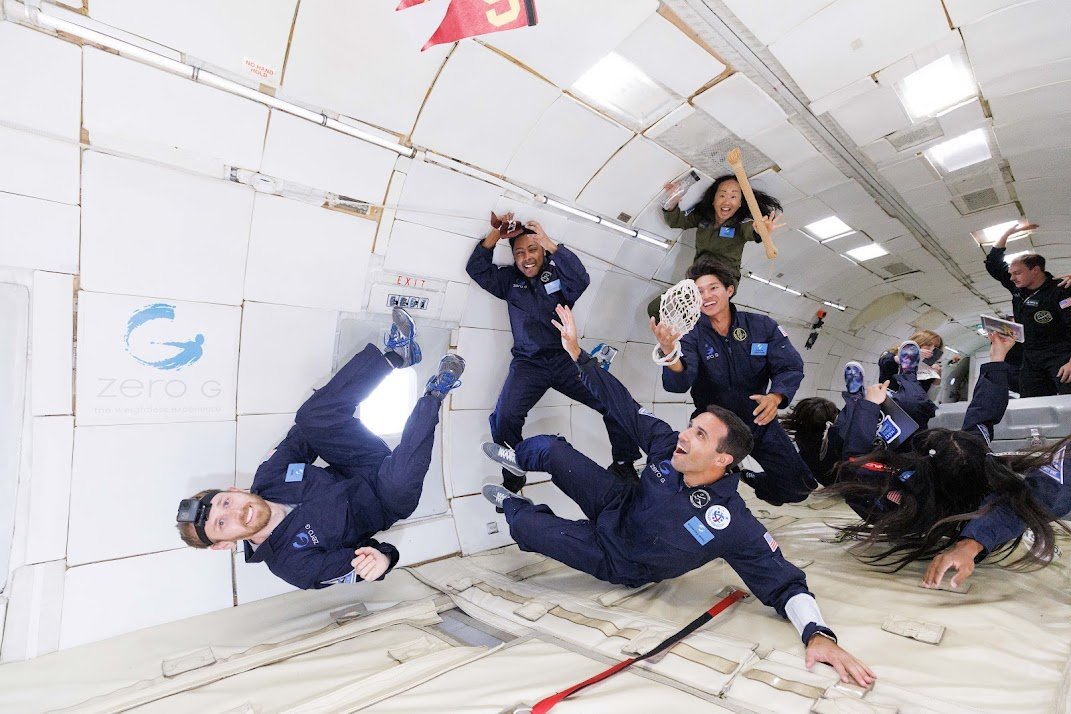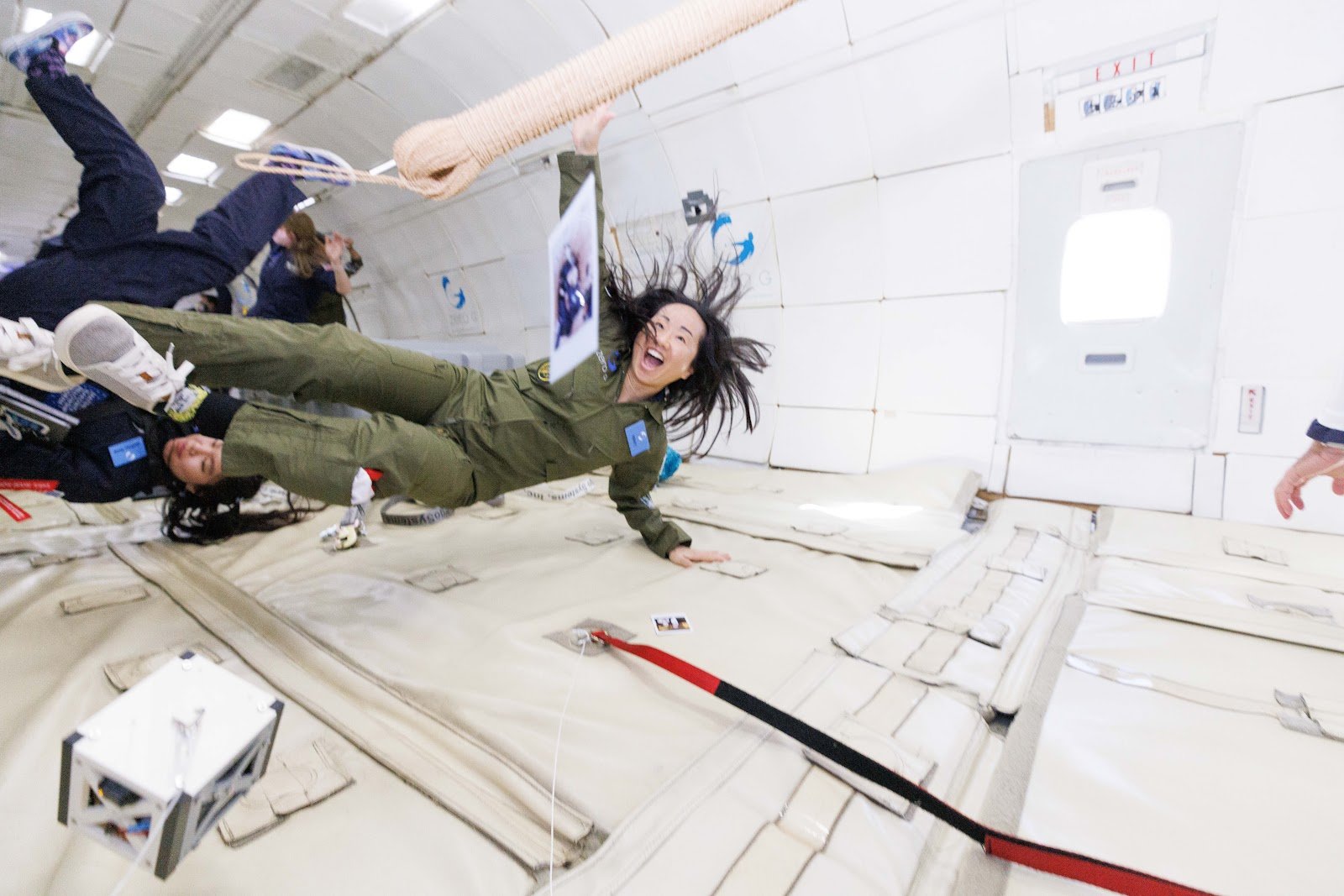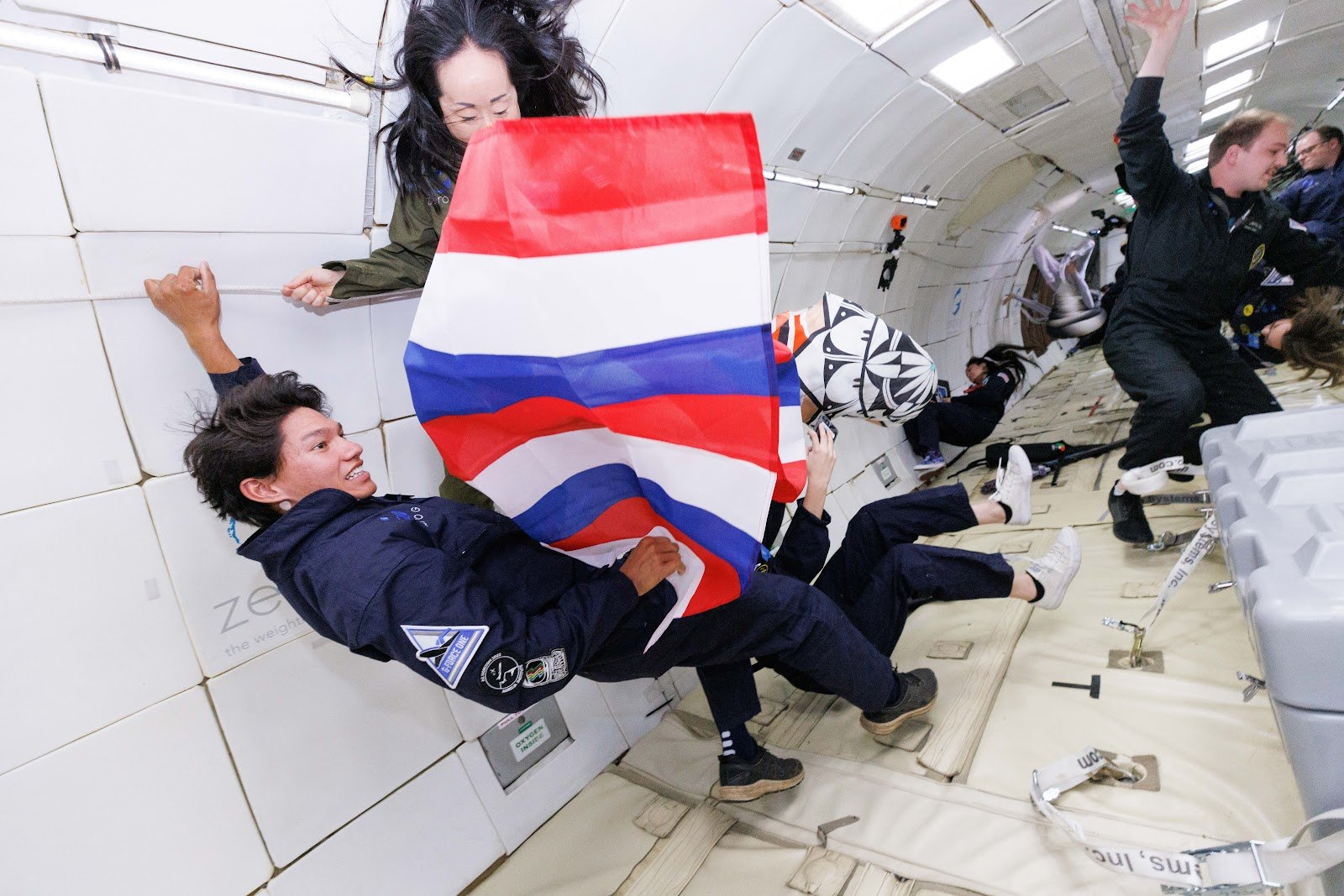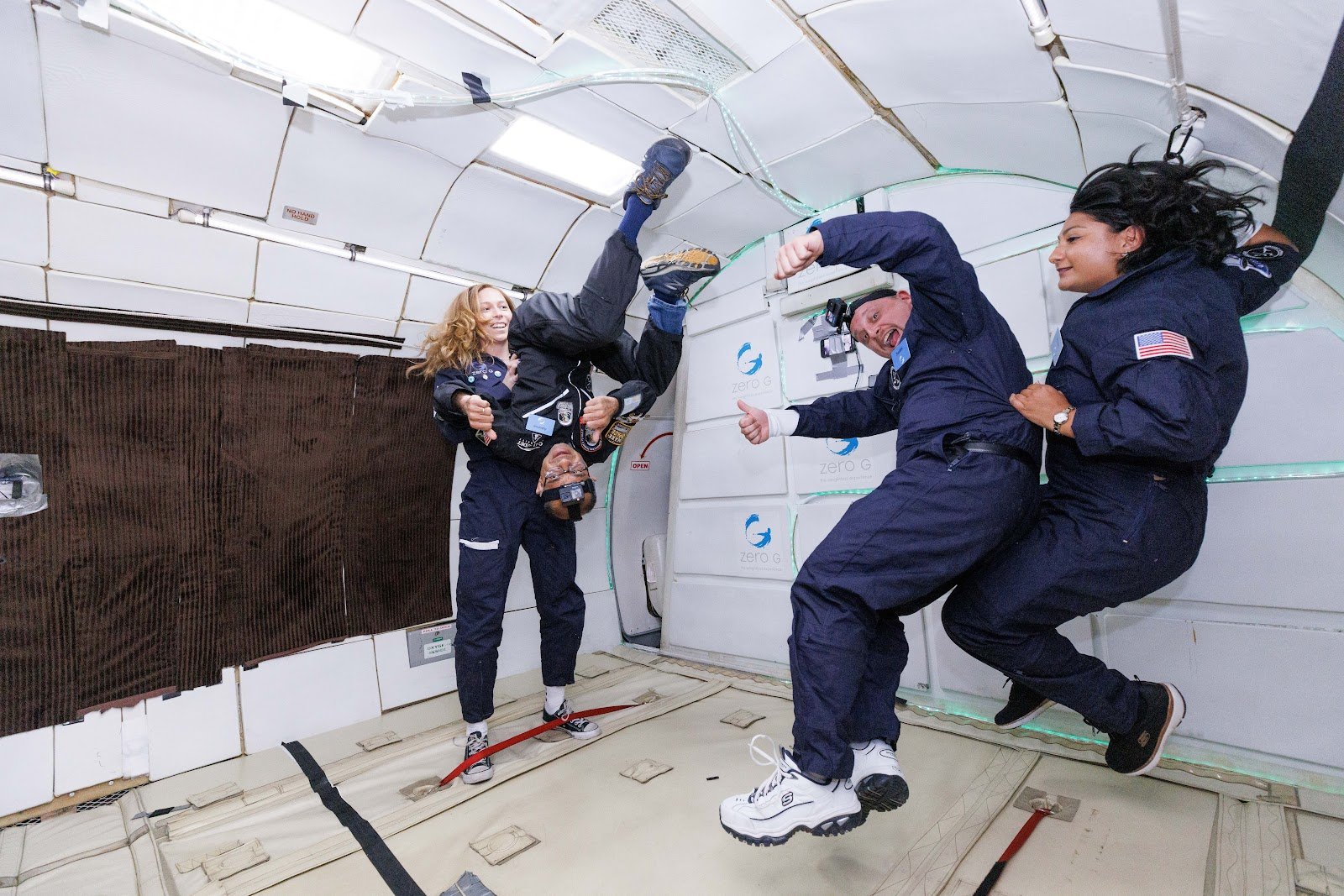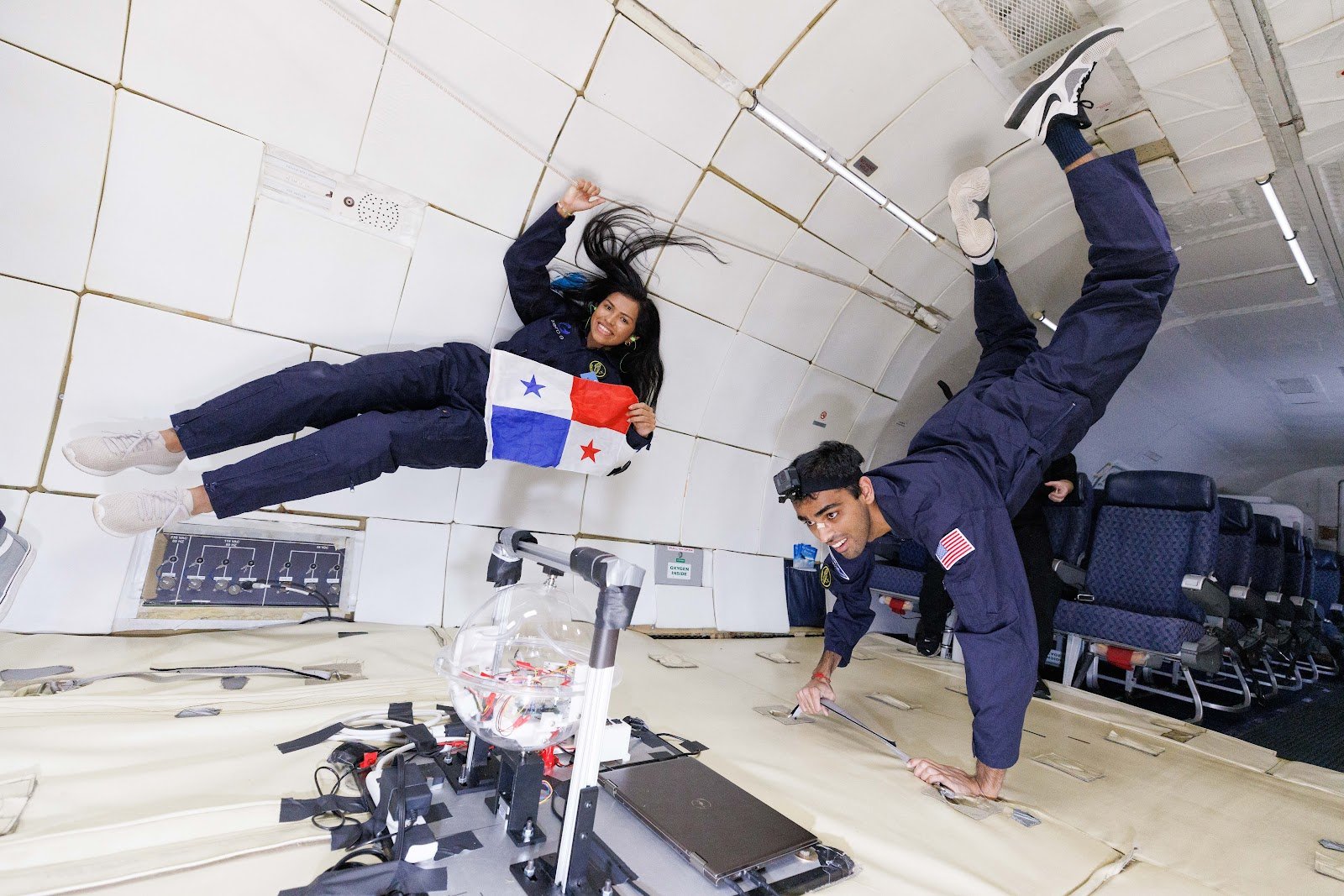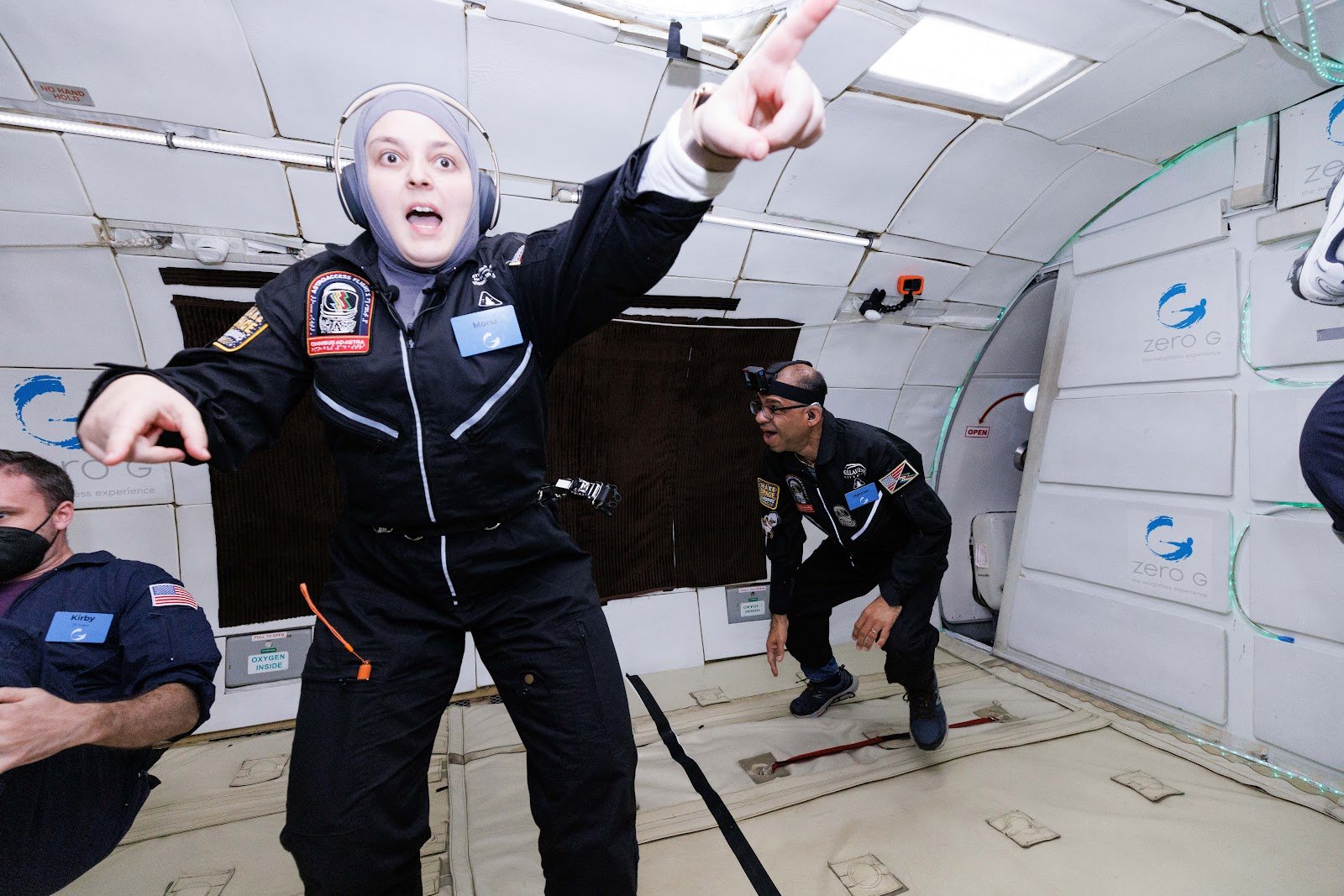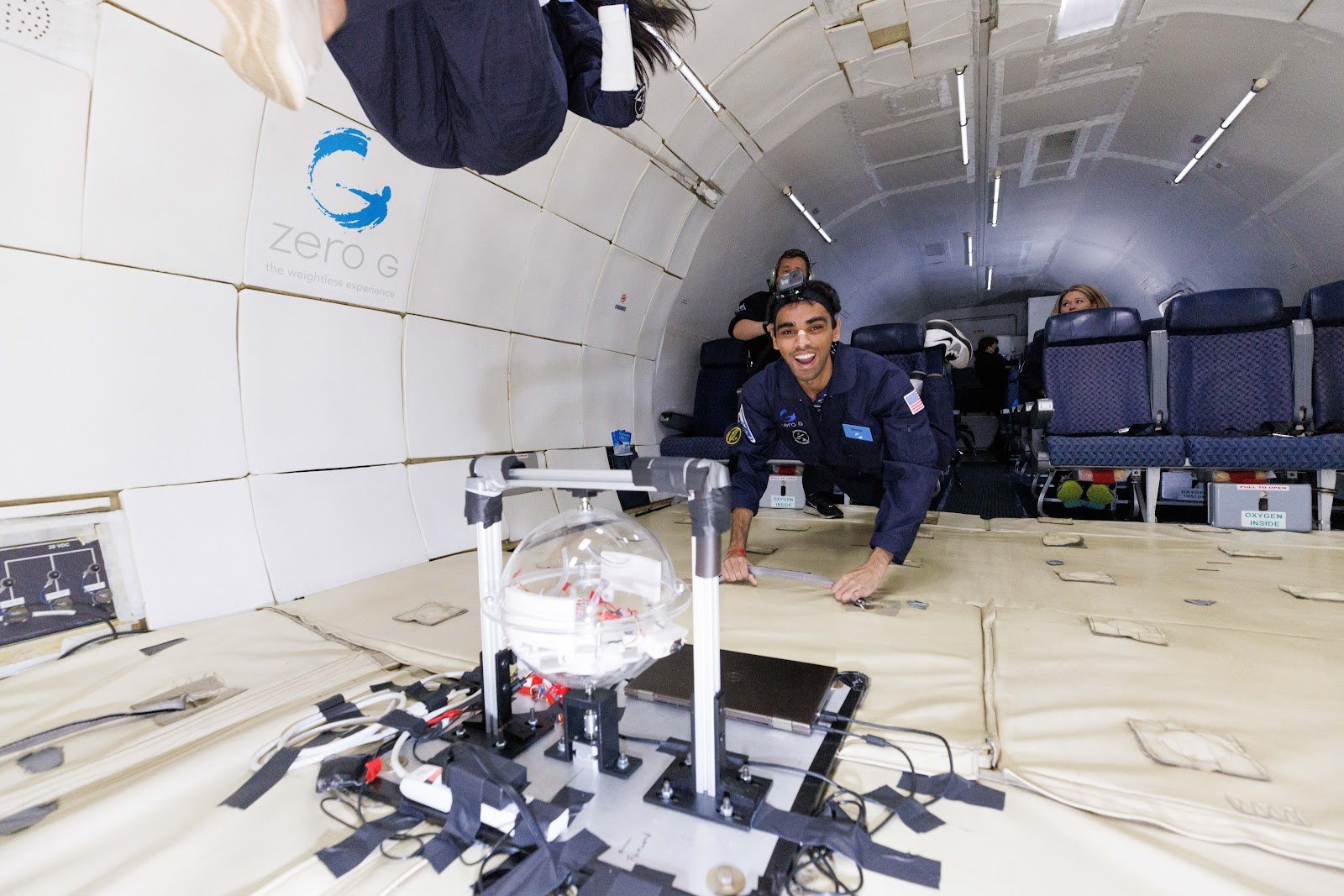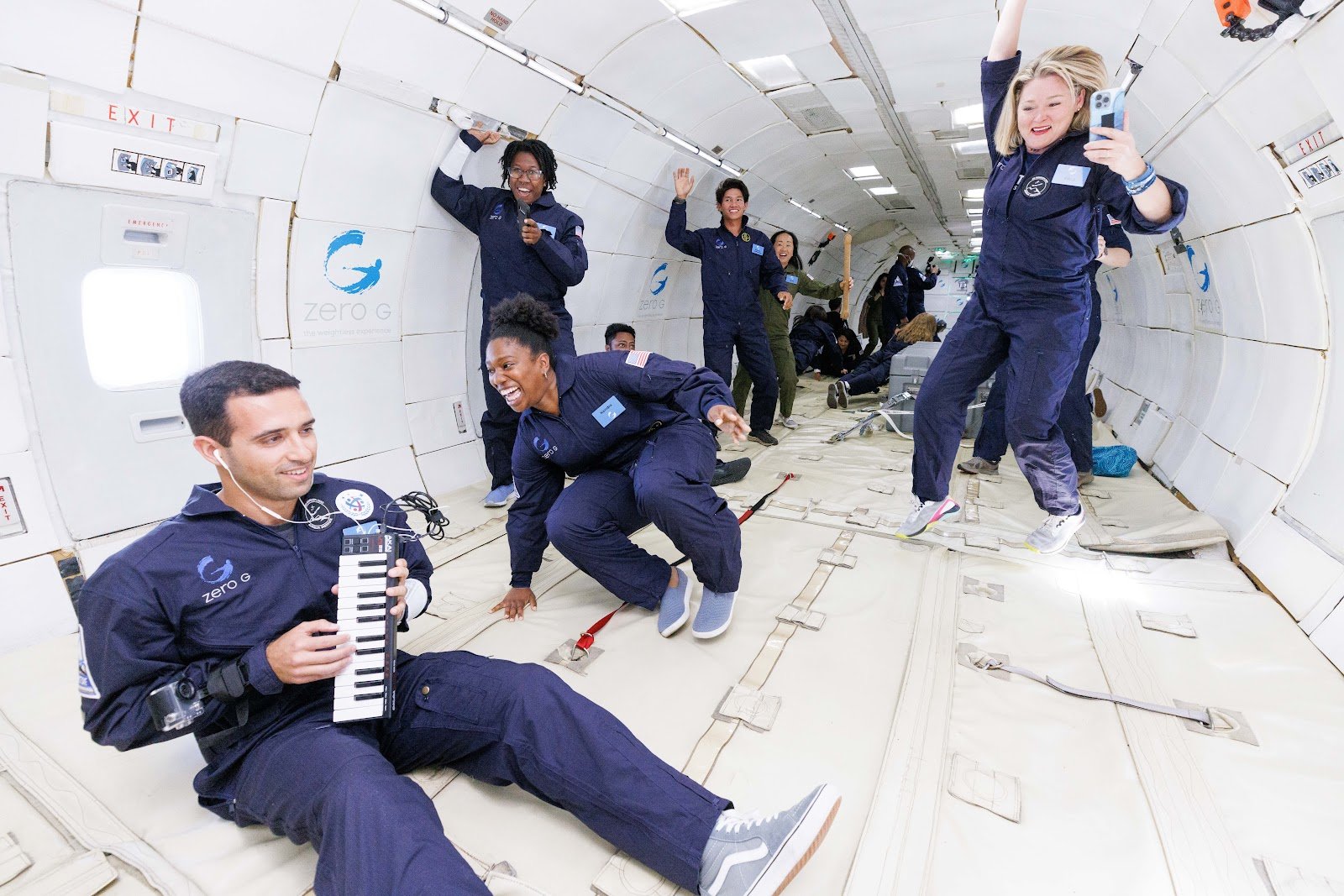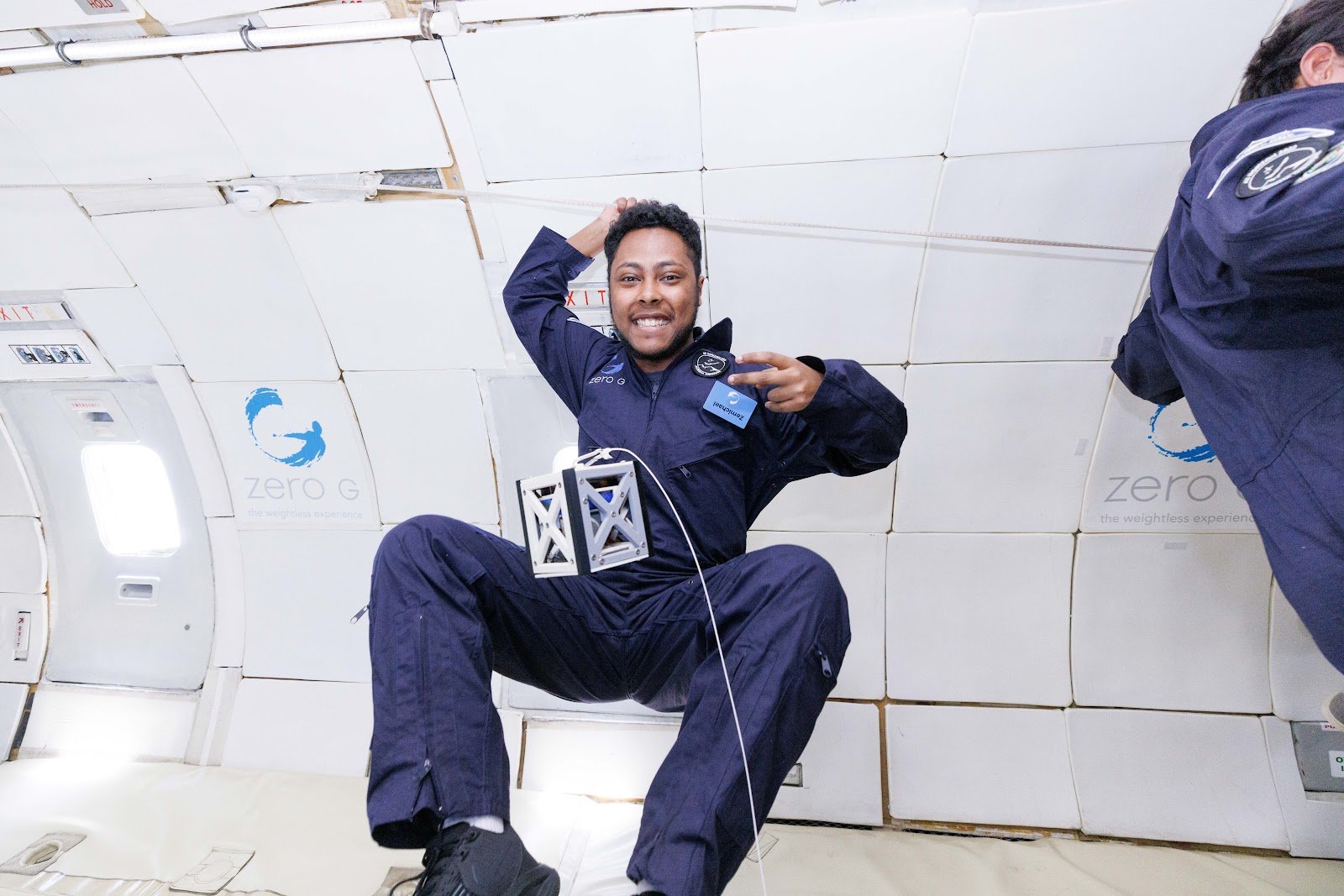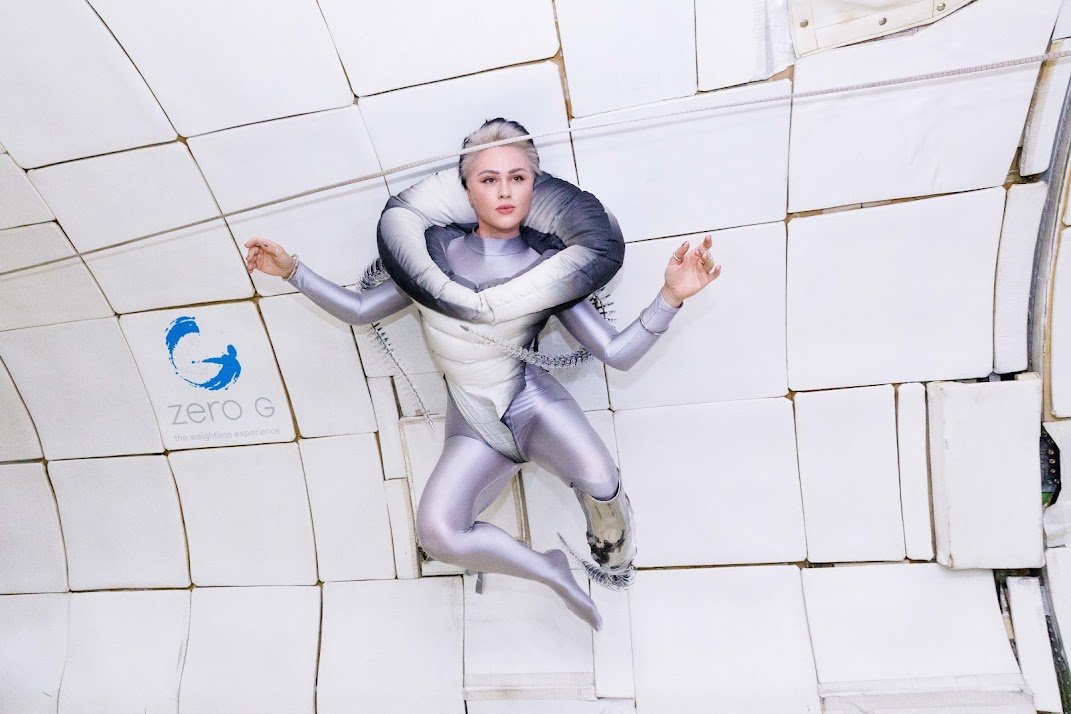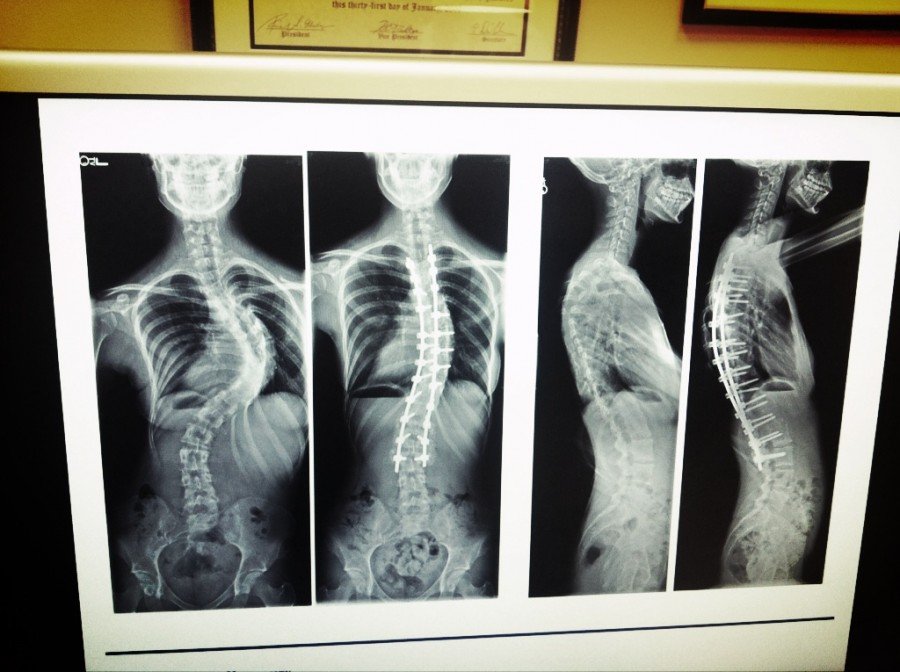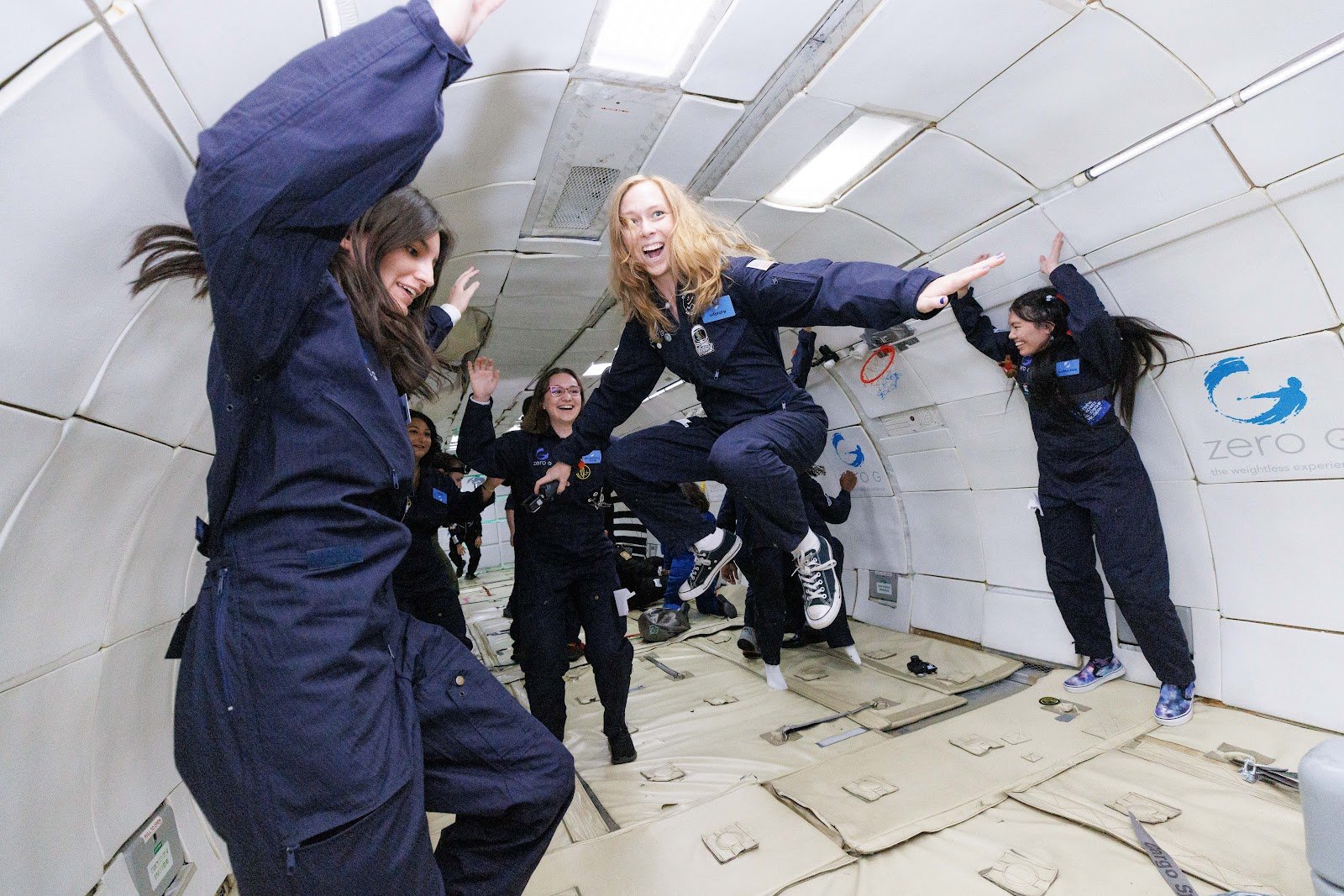See yourself in space
Aurelia Institute’s inaugural Horizon mission invited a unique cohort of fliers to share the experience of zero gravity
The Horizon 2022 fliers float in zero gravity. Photo credit: Steve Boxall/ZERO-G Corp
On May 22, 2022, Aurelia Institute’s inaugural Horizon zero gravity flight took off from Pease Airport in Portsmouth, New Hampshire. Included on the flight manifest: 25 people with backgrounds and expertise ranging from traditional Polynesian voyaging to music to product design to engineering; as well as a broomstick, a piano keyboard, coconut-fiber sennit, a plant habitat, a CubeSat, and numerous items of personal and cultural significance.
Over the course of 90 minutes, the Horizon fliers aboard ZeroG Corp’s G-Force One vessel experienced 20 parabolas of lunar, Martian, and zero gravity, each lasting about 20 seconds—the closest possible approximation to being off-planet. Each flier boarded the plane with a unique purpose: a research project, a storytelling goal, an artifact or artwork to create or display.
Parabolic flights offer unique opportunities for experience and experimentation in microgravity. Since the 1950s there’s a rich history of zero gravity flights being used for training, research, and recreation—though as a rule, chartered flights tend to focus on one or the other. Aurelia’s Horizon mission brings different goals, projects, and cultures into one place.
"With the Aurelia Horizon 2022 mission, we are building the future in space we want to see by inviting a diverse set of fliers to experience these flights and, more importantly, bringing them together to see each other, learn from each other, and feel invested in one another’s success," says Dr. Danielle DeLatte, Aurelia Institute co-founder and Chief Operations Officer, who headed the Horizon mission.
Horizon highlight: Polynesian Voyaging Society
Dr. Linda Furuto floats in zero gravity. Photo credit: Steve Boxall/ZERO-G Corp
Nālamakū Ahsing and Dr. Linda Furuto float in zero gravity. Photo credit: Steve Boxall/ZERO-G Corp
Dr. Linda Furuto and Nālamakū Ahsing joined the Horizon flight from the Polynesian Voyaging Society. They brought objects onboard as past, present, and future representations of the society’s mission: to perpetuate the art and science of traditional Polynesian voyaging and the spirit of exploration through experiential educational programs that inspire students and their communities to respect and care for themselves, each other, and their natural and cultural environments.
“Living on an island chain teaches us that our natural world is a gift with limits and that we must carefully steward this gift if we are to survive together. Our Pacific voyaging traditions teach us to venture beyond the horizon and into zero gravity to create global relationships as we work with, learn with, and learn from each other,” says Furuto. Onboard the flight with them:
'Aha/Sennit from the village in Satawal where our first teacher Master Navigator Pius Mau Piailug is from. Papa Mau taught us the importance of knowing who we are and where we come from. He taught us that once we know where we've come from, we can never be lost...no matter where we go.
Wai/Water from Ka Piko O Wākea, the navel of Wākea Sky Father also known as the equator. This is a sacred place that connects Oceania and our Pacific brothers and sisters. We sail as one Pacific family connecting the planet and beyond.
Pōhaku/Stone from Makapu'u, O'ahu and carried by Nālamakū on a recent sail from Hawai'i to Tahiti. The pōhaku keeps us firmly planted in our values such as love, kindness, compassion, strength, resiliency, and aloha.
Hae Hawai‘i/flag representing our homeland, as an offering and invitation to collectively engage in "Preparing humanity to become a spacefaring species.”
“The skills, fortitude, and resilience of the Polynesian navigators to sail into the unknown are valuable assets for future astronauts as we, as humanity, consider our expansion into the stars,” says DeLatte. “We hope this collaboration will illuminate another path and broaden the horizons of what is considered ‘sailing’ for this group of voyagers.”
Beyond Access
Aurelia Institute volunteers help Horizon 2022 fliers during their zero gravity flight. Photo credit: Steve Boxall/ZERO-G Corp
Each flier on the Horizon 2022 mission was invited to participate in the flight through Aurelia’s partnership with an array of organizations dedicated to diversifying the space industry, joined by Aurelia team members offering guidance and hands-on help.
In one sense, space is the ultimate equalizer: everyone who leaves Earth is subject to the radical experience of leaving gravity behind. The laws of gravity govern our physical existence on our home planet; and our lived experience of those laws shapes the way we think, our approach to design, our creativity—everything. With the advent of a thriving human presence in space, we have the opportunity to reimagine the human experience unbound by earthly constraints.
Easier said than done, perhaps. The more variety of people, ideas, and goals we can bring into the burgeoning space industry, the richer and more innovative life in space will be. But there are drastic barriers to entry, ranging from cost to physical challenges to technical difficulty to the distribution of where innovation happens and who is invited to participate.
Aurelia Institute hopes to lower those barriers by covering costs and providing training, education, and consultation on technical needs; then inviting a wide array of participants with wildly diverse aims and giving their experiences equal attention.
Horizon is the flagship mission of Aurelia’s Gateway program, which opens access to key technologies and experiences needed to engage with human spaceflight. Aurelia’s Horizon fliers benefit from the Aurelia team’s zero-g mission integration, teaching, and management expertise.
“Although not exactly rocket science, detailed expertise and knowledge of how to get projects onto microgravity platforms like the Zero G Corp parabolic flights, where FAA regulations and gravity transition hazards must be carefully considered, is still held by a relative few,” says DeLatte. The Aurelia Institute team’s deep experience in this area helped smooth the path for a diverse cohort of researchers, artists, and storytellers who may not have previously considered flying their projects.
“The sensation of floating, of true weightlessness, is a profound experience that inspires us to imagine life in space,” says Ariel Ekblaw, Aurelia Institute’s founder and CEO. “We want as many people as possible to have the opportunity to know that moment of joy and freedom. Aurelia Institute is working to enable a joyful, safe, and confident journey into space for the people who will build humanity’s future there.”
The art and science of delight in space
Some fliers were there purely for the experience: to be a part of the flight themselves, and to represent a group not often seen in space industry contexts.
Krystel Villaretta floats in zero gravity, sporting the flag of Panama. Photo credit: Steve Boxall/ZERO-G Corp
Krystel Villaretta, for example, selected for the cohort by NASA International SpaceApps Challenge for winning their global hackathon, joined the flight to represent her home country of Panama. Her goal was to document and share how a zero-g flight is done from start to finish. “The overall purpose is to tell this amazing story—explain the science behind a never-seen-before path in my country and make it as realistic and accessible as possible for young people with similar interests to live this experience through mine,” she says. Krystel plans to create a video explaining the experience from her point of view.
Dr. Mona Minkara flies in zero gravity without sight. Photo credit: Steve Boxall/ZERO-G Corp
Others joined the Horizon 2022 cohort to work on projects aimed at improving future flights for others. Apurva Varia, flying on behalf of Mission: AstroAccess, brought two experiments for deaf individuals. The first was an LED light system that a crew member or other passenger could control, turing on a green light when the flight approaches push over (telling the deaf flier to prepare for zero gravity), and a blue light when the plane approaches 1.8g’s (so the deaf flier knows it’s time to lie down). The second project was an experiment with ASL communication in different orientations; an ASL interpreter, Justin Baldi, joined the flight as well, and the two worked together to see if they could understand ASL when they were floating at opposite angles to each other.
Dr. Mona Minkara, also representing AstroAccess, explored how different textures (including corduroy and velcro) might be used by a blind individual to successfully orient themselves in a zero-gravity environment. Mikara also sees the potential value of this work for sighted fliers: “In an emergency, if the lights go out, and you and your crew mates are in zero gravity in the dark, what will that be like? It doesn’t have to be frightening (or even a big deal) if you have the right training and the right environmental cues,” she says. “The blind crew aboard this flight tested out some minor modifications to the cabin that we hope will make it easy to find your way around in microgravity, eyes-free.”
Horizon highlight: Ce-Ce Mazyck
Ce-Ce Mazyck hangs upside-down during the Horizon zero gravity flight, with Cady Coleman beside her. Photo credit: Steve Boxall/ZERO-G Corp
Centra “Ce-Ce” Mazyck also joined the Horizon cohort from AstroAccess. A wheelchair user since a military training accident nearly 20 years ago, Ce-Ce is a Paralympic athlete and disabilities advocate.
"My project was to orient myself and feel comfortable with doing it, especially coming in and out of parabolas. I am paralyzed with little to no balance, so I prefer to be rightside up, not upside down. I would love to control any movements while in zero-g, and also move about the cabin with ease. If I conquer that, I’m ready for SPACE!!” Mazyck bought cords with D-Rings for stabilization but found that the foot holds along the plane’s sides worked better. “I would not do another flight without them!” she says.
Mazyck worked closely on the flight with Cady Coleman, a former US astronaut and a member of Aurelia Institute’s advisory council.
Exhibition and experimentation
“My projects explore the exciting affordances of product design for zero-g. I ask myself: what will be the ubiquitous, practical, or just delightful daily objects surrounding humans living and working in microgravity environments? How might we encourage artists and designers to design for space?” says Anna Shaposhnik, representing the Zed Factor Fellowship. "For my three projects, it was one to represent me and dorky artists everywhere who just want to fly on a broom; one to represent friendships, and one to represent aspirations.”
Anna Shaposhnik flies on a custom witch’s broom during the Horizon zero gravity flight. Her other items onboard the flight included a fine-arts oriented water lamp, experimental fashion, and a model robot friend she calls Orbi. Photo credit: Steve Boxall/ZERO-G Corp
The Horizon 2022 cohort included fliers for whom the experience was the goal, and others for whom the flight itself was only the first step. Artists and researchers brought projects to test out, while educators and advocates are creating videos, articles, workshops, and other outreach efforts drawing on their experiences.
Allysa Kazhe floats with artwork from her Native heritage.
Photo credit: Steve Boxall/ZERO-G Corp
Says Allysa Kazhe, recipient of the Brooke Owens Fellowship: “My project was a creative storytelling piece that brings together Native heritage and the modern aerospace experience. I showcased two eagle feather art pieces both with traditional geometric designs combined with space symbolism. As well as, an Acoma Pueblo designed scarf to empathize movement within zero gravity.“ Kazhe plans to create a video and write an article detailing her experience.
Somayajulu Dhulipala works on his Agrifuge experiment in zero gravity flight. Photo credit: Steve Boxall/ZERO-G Corp
Somayajulu Dhulipala, joining the flight from MIT Students for the Exploration and Development of Space (SEDS), tested Agrifuge, a rotating plant habitat, to see what rotation rates lead to water flow rate in the pipes in microgravity conditions. “We hope to use this mission to gain more traction for the payload program. We also wish to use the data from the flight for our experiment to further develop Agrifuge and present our designs and efforts in several conferences,” says Dhulipala.
Zemichael Gebeyehu, representing the National Society of Black Engineers Special Interest Group (NSBE), tested a low-cost Attitude Determination and Control System (ADCS) for a 1U CubeSat. The results of the experiment will help his research team at Lehigh University Space Initiative to further develop HawkSat-1865, a CubeSat development and launch program over the next two years.
José Ferreira, an aerospace engineer and Fulbright Fellow representing the Space Generation Advisory Council, brought an electric piano aboard and spent the Horizon flight exploring the effect of gravitational pull in the way sounds are perceived and actions executed. He played a piece of music composed specifically for the microgravity flight, in an effort to assess sound perception and its cognitive process under different gravity environments.
José Ferreira plays an original composition in zero gravity. Photo credit: Steve Boxall/ZERO-G Corp
Zemichael Gebeyehu floats with his CubeSat experiment. Photo credit: Steve Boxall/ZERO-G Corp
Horizon highlight: Viktoria Modesta
Viktoria Modesta wears a custom prosthesis and flight suit during the Horizon 2022 flight. Photo credit: Steve Boxall/ZERO-G Corp
Viktoria Modesta, a self-described bionic pop artist and futurist, is an AstroAccess ambassador. Her project onboard the flight focused on “exploring hyper embodiment as well as philosophy and the very meaning of physical ‘ability’ in weightlessness. Working with alternative body architecture, micro gravity adapted prosthesis, conceptual fashion and choreography, she aims to release experimental content from the flight to advance the future human and post-disability narrative beyond Earth's gravity."
Be a beacon
Many fliers in the Horizon 2022 cohort are educators or STEM advocates, and they are focused on sharing their experiences with youth and underserved groups around the world.
Mya Guillaume dunks a miniature basketball during the Horizon zero gravity flight. Photo credit: Steve Boxall/ZERO-G Corp
Kendra Rivers, an NSBE Aerospace SIG flier, aims to inspire children from underrepresented groups in the aerospace industry. Following the flight, she hosted a workshop with school-aged girls from her community to tell them all about the NSBE Aerospace SIG and Aurelia Institute’s Horizon 2022 mission. “To hear the excitement from the girls and the responses, ‘I want to do that!’ and ‘That is so cool,’ was fulfilling. To be a seed sower/inspiration for girls from my community and beyond is my purpose,” says Rivers.
Erika Neuman is an Army veteran and a 5th grade STEM teacher in Texas. She brought a jar with 27 Sour Patch Kids to represent the 27 students in her class. “I will share my own experiences and story but also want to honor the research of others in ways to inspire my students and other young learners to ‘shoot for the stars,’” she says.
Amy Huynh joined the Horizon cohort from the Matthew Isakowitz Fellowship. She collaborated with STEAM outreach and nonprofit organization Dreams for Schools to display mobile apps and websites that middle school students in the program from underrepresented backgrounds had created. Mya Guillaume represented the Patti Grace Smith Fellowship, and joined the flight to take video of her fellow fliers and their projects, as well as herself doing everyday activities in zero gravity.
X-ray of Katelyn Hertel’s severely curved spine.Courtesy of Katelyn Hertel
"Not only did she walk again... she flew." Katelyn Hertel underwent full spinal surgery 10 years ago due to severe scoliosis at a 96 degree angle. During her recovery, after coming out of surgery paralyzed, she needed to relearn how to walk and do everyday activities, and retains some physical limitations in her movement despite being able to lead a normal life. The Horizon 2022 Gateway flight fulfilled a childhood dream she never thought she would achieve due to her disability.
“Almost 10 years ago the first picture was my reality and I was relearning how to walk and do daily activities. This past weekend I FLEW. What a wild journey this has been.”
Katelyn Hertel floats in zero gravity. Photo credit: Steve Boxall/ZERO-G Corp


